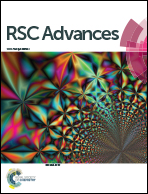Greatly enhanced dielectric permittivity in La1.7Sr0.3NiO4/poly(vinylidene fluoride) nanocomposites that retained a low loss tangent
Abstract
The effect of La1.7Sr0.3NiO4 nanoparticles (LSNO-NPs) on the dielectric properties of LSNO-NPs/polyvinylidene fluoride (LSNO-NPs/PVDF) composites is presented. LSNO-NPs/PVDF composites fabricated via a liquid-phase assisted dispersion and hot-pressing methods showed a homogeneous dispersion of LSNO-NPs in a PVDF polymer matrix. The dielectric permittivity (ε′) continuously increased with increasing volume fraction of LSNO-NPs from fLSNO = 0–0.20, following the effective medium theory and Lichtenecker's logarithmic models. This result was intrinsically caused by a very large ε′ ≈ 105 of LSNO-NPs ceramic particles. At fLSNO = 0.25, ε′ deviated from the conventional mixed models, indicating a dominant extrinsic effect. A rapid change in ε′ of LSNO-NPs/PVDF composites was observed when fLSNO > 0.3. A largely enhanced dielectric response with ε′ ≈ 3285 at 1 kHz was obtained at fLSNO = 0.35, while the loss tangent was still low (≈0.83). This extremely enhanced ε′ value is attributed to the large interfacial areas and very short interparticle distances between LSNO-NPs (≈20–30 nm) separated by a thin layer of PVDF, forming highly effective microcapacitors. The overall ε′ values are well described by the combination model of effective medium percolation theory.



 Please wait while we load your content...
Please wait while we load your content...